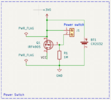circuitmaker
- Mar 20, 2024
- 11
- Joined
- Mar 20, 2024
- Messages
- 11
Hi everyone,
I am using an IRF4905 P-channel Mosfet to control the main circuit power supply. When the voltage is applied to the gate of the Mosfet the main circuit is disconnected from the power supply. Most of the time the "Power switch" is in a closed position, applying a voltage to the gate. I am curious how long the CR2032 3v battery would last in this case. How do I measure the current consumed by the IRF4905 Mosfet in a "sleep" mode? When I use a tester to measure the current, it shows zero amp usage. I can tell that the battery voltage is dropping within a week from 3.1V to 3V. Looks like it is discharging pretty fast. Ideally, it should last at least a year in a "sleep" mode. Will resistors help to extend the battery life?

I am using an IRF4905 P-channel Mosfet to control the main circuit power supply. When the voltage is applied to the gate of the Mosfet the main circuit is disconnected from the power supply. Most of the time the "Power switch" is in a closed position, applying a voltage to the gate. I am curious how long the CR2032 3v battery would last in this case. How do I measure the current consumed by the IRF4905 Mosfet in a "sleep" mode? When I use a tester to measure the current, it shows zero amp usage. I can tell that the battery voltage is dropping within a week from 3.1V to 3V. Looks like it is discharging pretty fast. Ideally, it should last at least a year in a "sleep" mode. Will resistors help to extend the battery life?

